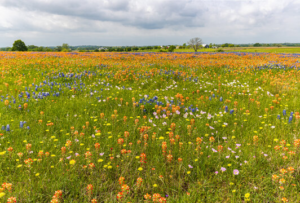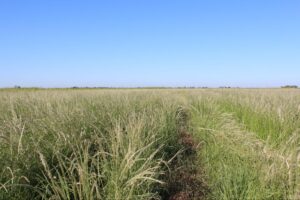
Controlling weeds is crucial during the initial stages of establishing native grasses. Weeds compete aggressively for resources and can significantly hinder the development of young native plants. Our team This post explores effective strategies for managing weeds to ensure the successful establishment and growth of native grasses.
Understanding Weed Competition
Weeds are not just unsightly; they are competitors that challenge native grasses for essential resources such as sunlight, water, and nutrients. This competition can be particularly detrimental during the early stages of growth when native grasses are most vulnerable. Understanding this dynamic is key to implementing effective weed control measures.
One of the best ways to be aggressive against competition from weeds is by having a blend of native grass species, forbs, and legumes. This diversity ensures that regardless of weather conditions—from wet to dry—your land remains productive and less hospitable to weeds. Additionally, introducing legumes enriches the soil with nitrogen, benefiting the entire plant community.
Pre-Planting Strategies for Controlling Weeds
The best prevention against weeds is proper preparation. Here are some tips to help ensure you have the best start to controlling weeds before you even put seeds in the ground.
- Soil Preparation: Proper soil preparation is the first line of defense against weeds. By removing existing weeds and their seeds from the planting area, you can reduce future outbreaks.
- Pre-emergent Herbicides: Applying pre-emergent herbicides can prevent weeds from germinating. It’s important to choose a herbicide that won’t harm the native grass seeds.
- Optimal Planting Time: Timing your planting to avoid the peak weed growth periods can significantly reduce weed pressure. This often means planting in late fall or early spring when weed seeds are less likely to germinate.
Seeding Rate: Planting native grasses densely can reduce the space available for weeds to establish, naturally reducing weed pressures. Increasing the seeding rate when planting can accomplish this.
Post-Planting Weed Management

After planting, it’s vital to monitor the area and address any emerging weeds.
- Post-emergent Herbicides: Selective post-emergent herbicides can target weeds without damaging native grasses. Timing the application correctly ensures the herbicides are effective and minimizes damage to young native grasses.
- Mechanical Methods: Unlike native grasses, weeds don’t respond well to mowing. Mowing before weed-setting is an effective way to control weeds and can keep weeds from setting seed.
Using a Nurse Crop for Weed Suppression
Nurse crops play a crucial role in reclamation projects by offering erosion control, providing wind protection for seedlings, and naturally suppressing weeds. These crops, which can include annual ryegrass, teff grass, sterile triticale, and various small grains, are particularly beneficial during the vulnerable early stages of perennial grass and forb establishment. The choice of nurse crop depends on the planting season: cool-season varieties like barley are ideal for fall, whereas warm-season varieties like millet suit spring planting. By integrating nurse crops into your reclamation strategy, you can leverage their growth to enhance ground cover, protect young plants from the elements, and reduce weed competition effectively.
Grazing Management
Grazing is an innovative and natural method for managing weeds in reclamation areas and pastures. When implemented correctly, livestock can significantly reduce weed populations by grazing on young weeds. However, it’s crucial to monitor the grazing patterns closely, as the nutritional value of weeds decreases sharply as they mature. Timely grazing prevents weeds from reaching maturity, thereby reducing their chance to seed and spread, effectively keeping weed growth in check while nourishing livestock.
It’s recommended to avoid grazing on newly planted land. We also recommend allowing pastures and grasslands to go to seed at the end of a grazing season so native grasses can be established for the next season.
Prescribed Burns for Effective Weed Management
Prescribed burning is a controlled and strategic approach utilized across various native habitats to manage land resources and achieve conservation goals. This method involves the use of a ‘ring fire’ technique, where a field is encircled with a combination of backfire, flank fire, and head fire. The primary purpose of prescribed burns is to rejuvenate native grasses as they exit dormancy, control emerging weed seedlings, and synchronize the growth stages of plants, which is particularly advantageous for seed production fields. Conducted typically in early to mid-March, these burns leverage the warmer temperatures of early spring to effectively reduce residual plant material and prepare the land for the upcoming growing season.
The ecological benefits of prescribed burning are manifold. The process not only helps in adding essential nutrients back to the soil but also accelerates the warming of the soil by clearing old thatch, facilitating quicker and more uniform seed germination and growth. Landowners not currently utilizing this practice may be missing out on one of the most robust tools available for resetting plant succession, enhancing the quality of browse, and eliminating litter from the landscape. Effective management of prescribed burns requires foresight and continuous commitment, often necessitating multiple burns over several years to restore habitats to their optimal condition. This long-term strategy is crucial for maintaining the health and productivity of the land, ensuring that native vegetation can thrive and support diverse ecosystems.
Long-term Weed Management
Here is the great thing about native grasses: they grow fast and strong and they can handle some competition once they have time to establish successfully. Their roots grow deep as well. This means they can beat out weeds for sunlight, water, and nutrients. And while weeds are known for growing quickly, they can’t do that without access to those things.
Once you have strong stands of native grasses, your weed management becomes much less hands-on. You can mow when necessary, but usually, native grasses will do the work of combatting weeds for you.
Effective weed control is integral to the success of establishing native grasses. By understanding weed dynamics and implementing a combination of pre-planting, post-planting, and long-term management strategies, you can significantly improve the health and productivity of your native grass projects.
For more guidance on selecting the right native grasses or to discuss your specific weed control needs, reach out to us at Bamert Seed Company. Let’s work together to grow something great!



